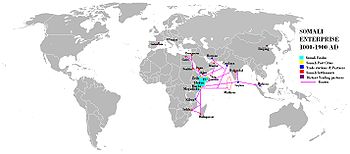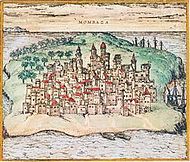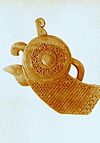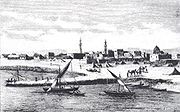- Maritime history of Somalia
-
Historical Somali commercial enterprise in the Red Sea, the Persian Gulf, the Indian Ocean, and the straits of Malacca.

Maritime history of Somalia refers to the seafaring tradition of the Somali people.[1] It includes various stages of Somali navigational technology, shipbuilding and design, as well as the history of the Somali port cities. It also covers the historical sea routes taken by Somali sailors which sustained the commercial enterprises of the historical Somali kingdoms and empires, in addition to the contemporary maritime culture of Somalia.
In antiquity, the ancestors of the Somali people were an important link in the Horn of Africa connecting the region's commerce with the rest of the ancient world. Somali sailors and merchants were the main suppliers of frankincense, myrrh and spices, items which were considered valuable luxuries by the Ancient Egyptians, Phoenicians, Mycenaeans and Babylonians.[2][3] During the classical era, several ancient city-states such as Opone, Mosylon and Malao (ancient) that competed with the Sabaeans, Parthians and Axumites for the wealthy Indo-Greco-Roman trade also flourished in Somalia.[4] In the Middle Ages, several powerful Somali empires dominated the regional trade including the Ajuuraan State, the latter of which maintained profitable maritime contacts with Arabia, India, Venetia,[5] Persia, Egypt, Portugal and as far away as China. This tradition of seaborne trade was maintained in the early modern period by later Somali states such as the Gobroon Dynasty.
Contents
Antiquity
In ancient times, the Kingdom of Punt, which is believed by several Egyptologists to have been situated in the area of modern-day Somalia, had a steady trade link with the Ancient Egyptians and exported precious natural resources such as myrrh, frankincense and gum. This trade network continued all the way into the classical era. The city states of Mossylon, Malao, Mundus and Tabae in Somalia engaged in a lucrative trade network connecting Somali merchants with Phoenicia, Ptolemic Egypt, Greece, Parthian Persia, Saba, Nabataea and the Roman Empire. Somali sailors used the ancient Somali maritime vessel known as the beden to transport their cargo.
Somali ship from Fra Mauro's map.
After the Roman conquest of the Nabataean Empire and the Roman naval presence at Aden to curb piracy, Arab and Somali merchants barred Indian merchants from trading in the free port cities of the Arabian peninsula[6] because of the nearby Roman presence. However, they continued to trade in the port cities of the Somali peninsula, which was free from any Roman threat or spies. The reason for barring Indian ships from entering the wealthy Arabian port cities was to protect and hide the exploitative trade practices of the Somali and Arab merchants in the extremely lucrative ancient Red Sea-Mediterranean Sea commerce.[7] The Indian merchants for centuries brought large quantities of cinnamon from Ceylon and the Far East to Somalia and Arabia. This is said to have been the best kept secret of the Arab and Somali merchants in their trade with the Roman and Greek world. The Romans and Greeks believed the source of cinnamon to have been the Somali peninsula but in reality, the highly valued product was brought to Somalia by way of Indian ships.[8] Through Somali and Arab traders, Indian/Chinese cinnamon was also exported for far higher prices to North Africa, the Near East and Europe, which made the cinnamon trade a very profitable revenue generator, especially for the Somali merchants through whose hands large quantities were shipped across ancient sea and land routes.
Somali sailors were aware of the region's monsoons, and used them to link themselves with the port cities of the Indian Ocean and the Red Sea. Another navigational technique was denning the islands of the Indian Ocean to navigate through the ancient trade routes.[9]
Middle Ages
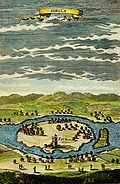 Somali merchants from Mogadishu established a colony in Mozambique to extract gold from the mines in Sofala.[10]
Somali merchants from Mogadishu established a colony in Mozambique to extract gold from the mines in Sofala.[10]
 Exotic animals such as the giraffe caught and sold by Somali merchants were very popular in medieval China.
Exotic animals such as the giraffe caught and sold by Somali merchants were very popular in medieval China.
During the Age of the Ajuuraans, the sultanates and republics of Merca, Mogadishu, Barawa, Hobyo and their respective ports flourished and had a lucrative foreign commerce with ships sailing to Arabia, India, Venetia,[5] Persia, Egypt, Portugal and as far away as China.
In the 16th century, Duarte Barbosa noted that many ships from the Kingdom of Cambaya in India sailed to Mogadishu with fabric and spices, for which they in return received gold, wax and ivory. Mogadishu, the center of a thriving weaving industry known as toob benadir (specialized for the markets in Egypt and Syria[11]), together with Merca and Barawa also served as transit stops for Swahili merchants from Mombasa and Malindi and for the gold trade from Kilwa.[12] Trade with the Hormuz went both ways, and Jewish merchants brought their Indian textile and fruit to the Somali coast in exchange for grain and wood.[13] Trading relations were established with Malacca in the 15th century,[14] with cloth, ambergris and porcelain being the main commodities exchanged.[15] Giraffes, zebras and incense were exported to the Ming Empire of China, which established Somali merchants as leaders in the commerce between the Asia and Africa,[16] and in the process influenced the Chinese language with the Somali language. Hindu merchants from Surat and Southeast African merchants from Pate, seeking to bypass both the Portuguese blockade and Omani meddling, used the Somali ports of Merca and Barawa (which were out of the two powers' jurisdiction) to conduct their trade in safety and without interference.[17]
During the same period, Somali merchants sailed to Cairo, Damascus, Mocha, Mombasa, Aden, Madagascar, Hyderabad and the islands of the Indian Ocean and the Red Sea, establishing Somali communities along the way. These travels produced several important individuals such as the Muslim scholars Uthman bin Ali Zayla'i in Egypt, Abd al-Aziz of Mogadishu in the Maldives, as well as the explorer Sa'id of Mogadishu, the latter of whom traveled across the Muslim world and visited China and India in the 14th century.
Early modern era and present
"The Somali wanders afar. You will find him working as deck hand, fireman, or steward, on all the great liners trading to the East. I know of a Somali tobacconist in Cardiff, a Somali mechanic in New York, and a Somali trader in Bombay, the latter of whom speaks French, English, and Italian fluently". (Rayne, 1921, 6)[18]
In the early modern period, successor states of the Adal and Ajuuraan empires began to flourish in Somalia, continuing the tradition of seaborne trade established by previous Somali empires. The rise of the 19th century Gobroon Dynasty in particular saw a rebirth in Somali maritime enterprise. During this period, the Somali agricultural output to Arabian markets was so great that the coast of Somalia came to be known as the Grain Coast of Yemen and Oman.[19] Somali merchants also operated trade factories on the Eritrean coast.[20]
During the brief period of imperial hegemony over Somalia, Somali sailors and traders frequently joined British and other European ships to the Far East, Europe and the Americas.
Somalia in the pre-civil war period possessed the largest merchant fleet in the Muslim world. It consisted of 12 oil tankers (average size 1300 tons), 15 bulk ore carriers (average size 15000 tons), and 207 other crafts with average tonnage of 5000 to 10000.[21]
In ancient times, naval engagements between buccanneers and merchant ships were very common in the Gulf of Aden. In the early Middle Ages, a Somali army invaded Aden in Yemen and expelled the Malagasy rulers, and afterwards settled in the city and the surrounding valley.[22][23] In the late medieval period, Somali navies regularly engaged their Portuguese counterparts at sea, the latter of whom were naturally attracted by the commercial reputation of the Somali coast. These tensions significantly worsened during the 16th century.
Over the next several decades Somali-Portuguese tensions would remain high and the increased contact between Somali sailors and Ottoman corsairs worried the Portuguese, prompting the latter to send a punitive expedition against Mogadishu under Joao de Sepuvelda. The expedition was unsuccessful.[25] Ottoman-Somali cooperation against the Portuguese in the Indian Ocean reached an apogee in the 1580s, when Ajuuraan clients of the Somali coastal cities began to sympathize with the Arabs and Swahilis under Portuguese rule and sent an envoy to the Turkish corsair Mir Ali Bey for a joint expedition against the Portuguese. Bey agreed and was joined by a Somali fleet, which began attacking Portuguese colonies in Southeast Africa.[26] The Somali-Ottoman offensive managed to drive out the Portuguese from several important cities such as Pate, Mombasa and Kilwa. However, the Portuguese governor sent envoys to India requesting a large Portuguese fleet. This request was answered and it reversed the previous offensive of the Muslims into one of defense. The Portuguese armada managed to re-take most of the lost cities and began punishing their leaders. However, they refrained from attacking Mogadishu.[27]
The Dervish navy in the early modern period served as a reconnaissance unit in the Red Sea and the Indian Ocean, spying on the British in Arabia.
During the post-independence period, the Somali Navy mostly did maritime patrols so as to prevent ships from illegally infringing on the nation's maritime borders. The Somali Navy and Somali Air Force also regularly collaborated as a deterrent against the Imperial Navy of Ethiopia. In addition, the Somali Navy carried out Search and Rescue (SAR) missions. The National Navy participated in many navy exercises with the United States Navy, the Royal British Navy and the Royal Canadian Navy in the Red Sea and the Indian Ocean.
Technology and equipment
- Beden – The prime ancient Somali maritime vessel that today remains the longest surviving sewn ship in East Africa and the world. The ship's construction style is unique to Somalia and significantly differs from extinct sewn ships of Arabia, South India and adjacent islands. An average Beden ship measures 10m or more and is strengthened with a substantial gunwale, attached by trenails. The Somali fishermen also use stone anchors to prevent their ships from being drawn to the shore when fishing.
- Stone anchor shanks – Heavy rocks put on the seabed (or on the beach) to moor ships. They were shaped like truncated cones and had two holes as fairleads for the mooring lines. Until a century ago, they were used by ships when they had to stay offshore for a long time and the anchor alone did not guarantee complete safety.
- Lighthouses – Somalia's historical strategic location within the world's oldest and busiest sea-lanes encouraged the construction of lighthouses to coordinate shipping and to ensure the safe entry of commercial vessels in the nation's many port cities.
- Hourglass – Hourglasses were used on Somali ships for timekeeping.
Port cities
Ancient
- Opone – In ancient times, the port city of Opone traded with merchants from Phoenicia, Egypt, Greece, Persia and the Roman Empire, and connected with traders from as far afield as Indonesia and Malaysia, exchanging spices, silks and other goods.
- Tabae – Ancient port where sailors on their way to India could take refuge from the storms of the Indian Ocean.
- Cape Guardafui – Known in ancient times as the Cape of Spices, it was an important place for the ancient cinnamon and Indian spice trade.
- Mosyllon – The most important ancient port city of the Somali Peninsula, it handled a considerable amount of the Indian Ocean trade through its large ships and extensive harbour.
- Malao – Ancient port city known for its commerce in frankincense and myrrh in exchange for cloaks, copper and gold from Arsinoe and India.
- Mundus – Ancient port engaged in the fragrant gum and cinnamon trade with the Hellenic world.
Medieval
- Barawa – Old port city in Somalia, which in the medieval era came under the influence of Mogadishu and the later Ajuuraan Empire.
- Berbera – Dominant port city on the Gulf of Aden that had trade relations with the Tang Dynasty of China.
- Gondershe – Medieval center of trade that handled smaller vessels sailing from India, Arabia, Persia and the Far East.
- Hobyo – One of the commercial centers of the Ajuuraans and an important port city for the pilgrimage (hajj) to Mecca.
- Kismayo – Sister city of Mogadishu and an important trade outlet during the Gobroon Dynasty.
- Merka – Prominent medieval port city that collaborated with the Mogadishans in the Indian Ocean trade.
- Mogadishu – The most important medieval city in East Africa and initiator of the East African gold trade. Before the period of civil strife, Mogadishu continued its historical position as the pre-eminent port city of East Africa.
- Zeila – Adalite city that traded with the Catalans and the Ottomans. Handled most of the trade of the northwestern Horn of Africa.
Early modern and present
 The northern port hub of Bosaso stands as one of the fastest growing cities in Somalia.
The northern port hub of Bosaso stands as one of the fastest growing cities in Somalia.
- Qandala – An important port city in the 18th and 19th centuries for the pilgrimage to Mecca, and for the caravan trains that came from the castle city of Botiala.
- Las Khorey – Capital of the Warsangali Sultanate, it was at its zenith during the late 18th century. Today, the port continues to export mainly marine products. Somali environmentalist Fatima Jibrell is re-developing the centuries-old port with the aim of creating immediate employment for local residents. Over the long-term, this effort is intended to boost import and export opportunities to Somalia's northern coastal region, and thus also help rebuild communities and livelihoods.
- Bosaso – Established by the Somali seafaring company Kaptallah in the early 19th century as Bandar Qassim, Bosaso has today become one of the fastest growing cities in Somalia and has replaced Mogadishu as the top port city.
- Eyl – A Dervish city that was utilized for the weapons trade during the Scramble for Africa. Today, Eyl is a growing port city.
See also
- Maritime history
- History of Somalia
- Ajuuraan State
- Gobroon Dynasty
- Thalassocracy
- Somali Navy
References
- ^ Charles Geshekter, "Somali Maritime History and Regional SubCultures: A Neglected Theme of the Somali Crisis
- ^ Phoenicia pg 199
- ^ The Aromatherapy Book by Jeanne Rose and John Hulburd pg 94
- ^ Oman in history By Peter Vine Page 324
- ^ a b Journal of African History pg.50 by John Donnelly Fage and Roland Anthony Oliver
- ^ E. H. Warmington, The Commerce Between the Roman Empire and India, (South Asia Books: 1995), p.54
- ^ E. H. Warmington, The Commerce Between the Roman Empire and India, (South Asia Books: 1995), p.229
- ^ E. H. Warmington, The Commerce Between the Roman Empire and India, (South Asia Books: 1995), p.186
- ^ Historical relations across the Indian Ocean: report and papers of the - Page 23
- ^ pg 4 - The quest for an African Eldorado: Sofala, By Terry H. Elkiss
- ^ Gujarat and the Trade of East Africa pg.35
- ^ The return of Cosmopolitan Capital:Globalization, the State and War pg.22
- ^ The Arabian Seas: The Indian Ocean World of the Seventeenth Century By R. J. Barendse
- ^ Gujarat and the Trade of East Africa pg.30
- ^ Chinese Porcelain Marks from Coastal Sites in Kenya: aspects of trade in the Indian Ocean, XIV-XIX centuries. Oxford: British Archaeological Reports, 1978 pg 2
- ^ East Africa and its Invaders pg.37
- ^ Gujarat and the Trade of East Africa pg.45
- ^ Nomads, sailors and refugees. A century of Somali migration pg 6
- ^ East Africa and the Indian Ocean By Edward A. Alpers pg 66
- ^ voyage to Abyssinia, and travels into the interior of that country by Henry Salt pg 152
- ^ Pakistan Economist 1983 -Page 24 by S. Akhtar
- ^ Page 192 - On the Arab System of Nautical Orientation, by Marina Tolmacheva - Arabica 1980
- ^ Page 761 - Encyclopaedia of the history of science, technology, and medicine in non-western cultures, By Helaine Selin
- ^ Tanzania notes and records: the journal of the Tanzania Society pg 76
- ^ The Portuguese period in East Africa - Page 112
- ^ Portuguese rule and Spanish crown in South Africa, 1581-1640 - Page 25
- ^ Four centuries of Swahili verse: a literary history and anthology - Page 11
Categories:- Somali maritime history
- History of Somalia
- Ajuuraan State
- Somalian culture
- Maritime history by country
Wikimedia Foundation. 2010.

